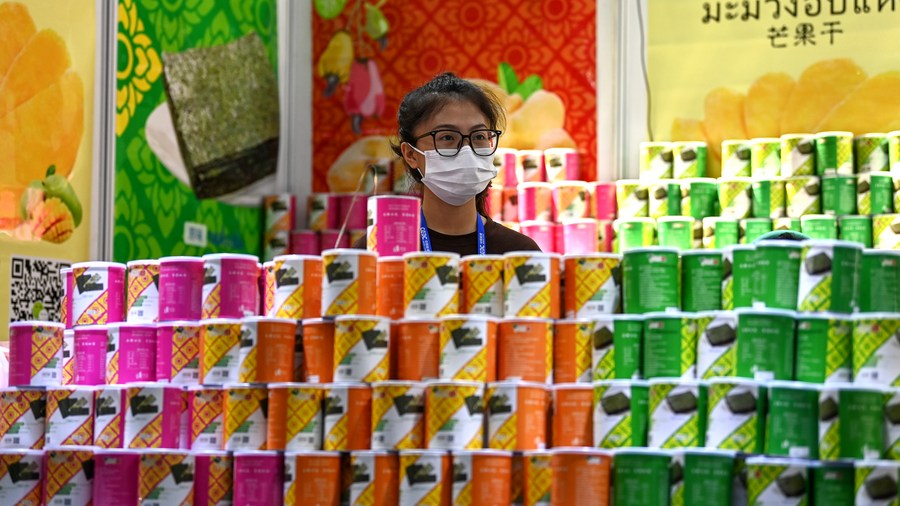
An exhibitor presents dried mango from Thailand during the 19th China-ASEAN Expo in Nanning, capital of south China's Guangxi Zhuang Autonomous Region, Sept. 18, 2022. (Xinhua/Zhang Ailin)
NANNING, Sept. 20 (Xinhua) -- In the memory of Chen Jiqing, a fruit trader in the border city of Dongxing, south China's Guangxi Zhuang Autonomous Region, his first impression of ASEAN fruits was rambutan, mango, and coconut brought by multinational traders near the border trade market when he was a child.
"There were only a few varieties and quantities of fruits from ASEAN countries at that time. Most of these fruits had to be sold out that day or they wouldn't be fresh," Chen said.
At that time, due to backward logistics and fresh-keeping technology, fruits from ASEAN countries were generally only sold in border areas.
Nowadays, cross-border fruit trade supported by express lines and cold chain logistics has already replaced small-scale fruit trade around the border areas.
Chen's company is already one of the largest fruit trading enterprises in Dongxing. In the peak season of durian production, it can ship more than 40 containers of fresh durian to the inland provinces of China in one month.
According to statistics, in 2004, China imported 300 million U.S. dollars of fruits from ASEAN countries. In 2001, China imported 15.22 billion dollars of dried and fresh fruits and nuts, of which five ASEAN countries (Thailand, Vietnam, Philippines, Cambodia, and Malaysia) accounted for more than 60 percent.
Thanks to the vigorous development of economic and trade relations between China and ASEAN, Chongzuo City in Guangxi, on the border of China and Vietnam, has become the largest city for import and export of border trade fruits in China, and its imported tropical fruits account for more than half of the whole country.
In Guangzhou, Shenzhen, Shanghai, Nanning, and other cities in China, snacks, cakes, drinks, and other products made with durian, dragon fruit, mango, longan, and other fruits from ASEAN countries as raw materials, have become popular in recent years, enriching the table of Chinese consumers. Some food enterprises also take a fancy to the business opportunities, which helps extend the industry chain of fruits from ASEAN countries.
In Nanning City, capital of Guangxi, Xuanma, a bakery food brand ranked among the top-selling brands on e-commerce platforms, also sees the opportunity brought by the booming fruit trade between China and ASEAN countries. It produces durian cakes made from imported durian.
Tang Chunlong, deputy general manager of Guangxi Xuanma Food Co., Ltd., said the durian cakes retain the fresh smell of durian, and could be produced and shipped to the customers on the same day after receiving orders from e-commerce platforms. These durian cakes are now sold across the country.
The product gained popularity in the market as soon as it was launched in 2019, and the annual sales increased rapidly from 800,000 yuan (about 115,280 U.S. dollars) at the beginning to more than 10 million yuan in 2021. Inspired by the popularity of durian cakes, the company plans to develop more baked goods with imported fruits from ASEAN countries as raw materials.
Thanks to the New International Land-Sea Trade Corridor -- a trade and logistics passage, with Chongqing being the key operation center, fruits from ASEAN countries could be transported to the western part as well as more inland provinces of China.
"In the past, via traditional logistics routes, ASEAN goods had to be transferred to local ports first, then to eastern cities of China by sea, before being transported to the western region of China via domestic trunk logistics. It took a long time," said Mai Liang with China (Guangxi) Pilot Free Trade Zone Qinzhou Port Area Development and Investment Group Co., Ltd. "The problem was that shipping costs were high and it took too much time, making it difficult for fresh ASEAN fruits to reach the dining table of Chinese consumers quickly."
Today, the logistics network of the new land-sea corridor in western China has been rapidly expanded, forming three main lines in the east, the middle, and the west; and different logistics forms, including rail-sea transport. The destinations of the corridor have been expanded to 319 ports in 107 countries and regions.
At the 19th China-ASEAN Expo, held from Sept. 16 to 19 in Nanning, the fruit trade also played a very important role. A number of tropical fruits from ASEAN countries were presented and sold at the expo.




 A single purchase
A single purchase









